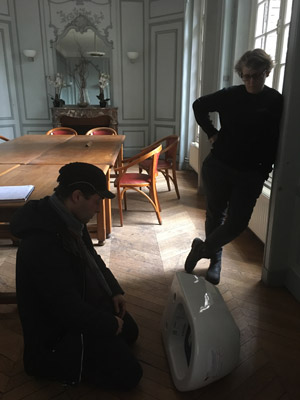French people love acronyms. Most of the people presently roaming the building with a computer and some files under their arm, coming in and out of meetings, looking often worried, sometimes satisfied, scratching their heads under a hard hat, usually go by an acronym. Only other members of their mysterious professions know what they stand for.
First comes the MOA, « maîtrise d’ouvrage » or « maître de l’ouvrage » which in this case, would be a « maitresse », i.e. the Fondation des Etats-Unis and its management. They are the ones who chose to launch the East Side Story project. The MOA often cannot supervise all the work by themselves. There are technical, legal and financial aspects to construction that require various experts. The MOA may hire an AMO, « assistance à maîtrise d’ouvrage », who stands in for the MOA throughout the project. The AMO does not draw anything or lay out any technical blueprints. They advise the MOA in deciding what they want and how they want to do it, thanks to their experience and understanding of what is feasible. The AMO stays with the MOA from the start to the very end of the project. They will help with the choice of an architect, of the insurance company, of the contractors, and all the administration that goes with it. The AMO also makes sure the project meets all the legal requirements, especially regarding authorizations and technical controlling.
A CT (« contrôleur technique ») is hired to constantly check the project respects current regulations, a CSPS (« coordinateur santé et protection de la sécurité ») is hired to verify that good work condition regulations are respected, a CSSI (« coordinateur de système de sécurité incendie ») is specifically in charge of fire regulations. The AMO also keeps track of the budget.
The MOE (« maître d’oeuvre ») is hired to actually draw the project. They can be a general contractor or, in our case, an architect and their team of engineers and technicians specialized in structural architecture, plumbing, electricity, acoustics…along with a construction economist. They must draw detailed blueprints and provide a thick file containing all the technical information the construction companies will work with. The economist must estimate the cost of the project to make sure it is feasible and give the MOE and AMO the information they need to negociate prices with the contractors. On East Side Story, separate contractors were consulted for each specific craft (plumbing, electricity, etc) rather than resorting to a general contractor, under six different sections. The contractual requirements are drawn up by the MOE and the contracts and other business papers are drawn up by the AMO. Once all the companies have handed in their price proposals, and negotiations have taken place, the contracts are signed. Now, everyone must work together.
This is when an OPC (« ordonnancement, planning, coordination ») is needed, a sort of conductor for the worksite. They are independent from both the MOE and the contractors. They plan who works when, before and after whom, as to be most efficient. The goal is for each task to be ordered at the right time, without undue overlapping or mischeduling. For example, you cannot have a painter work before the tiles are dry or the walls are up. On the worksite, the MOE makes sure the architectural project is respected given all the technical constraints, while the OPC is making sure everything goes according to plan.
East Side Story Credits :
MOA : Sophie Vasset et Anne Crémieux
AMO : Ana Duarte et Bertrand Phélippeau (OskaProd)
MOE : Hervé Leroy, architecte (Atelier Circonflexe Architecte), Noémie Sechet, Vincent Secoué, Alexandre Yvon, ingénieurs (Espace-Temps), Rémi Mercier, économiste (Agence F. Bougon), Alexandre Michelis, ingénieur structure (Delta) Alexis Trémeau, acousticien (Alternative)
OPC : Morci Chouchane et Alain Champenois (Mercure engineering)
CT : Valentin Martine (Qualiconsult)
CSPS : Bertrand Ganga (Bureau Veritas)
SSI : Patrice Chardeau (GLI)

The MOE and MOA are pondering over whether the toilet bowl is appropriate for the rooms.



